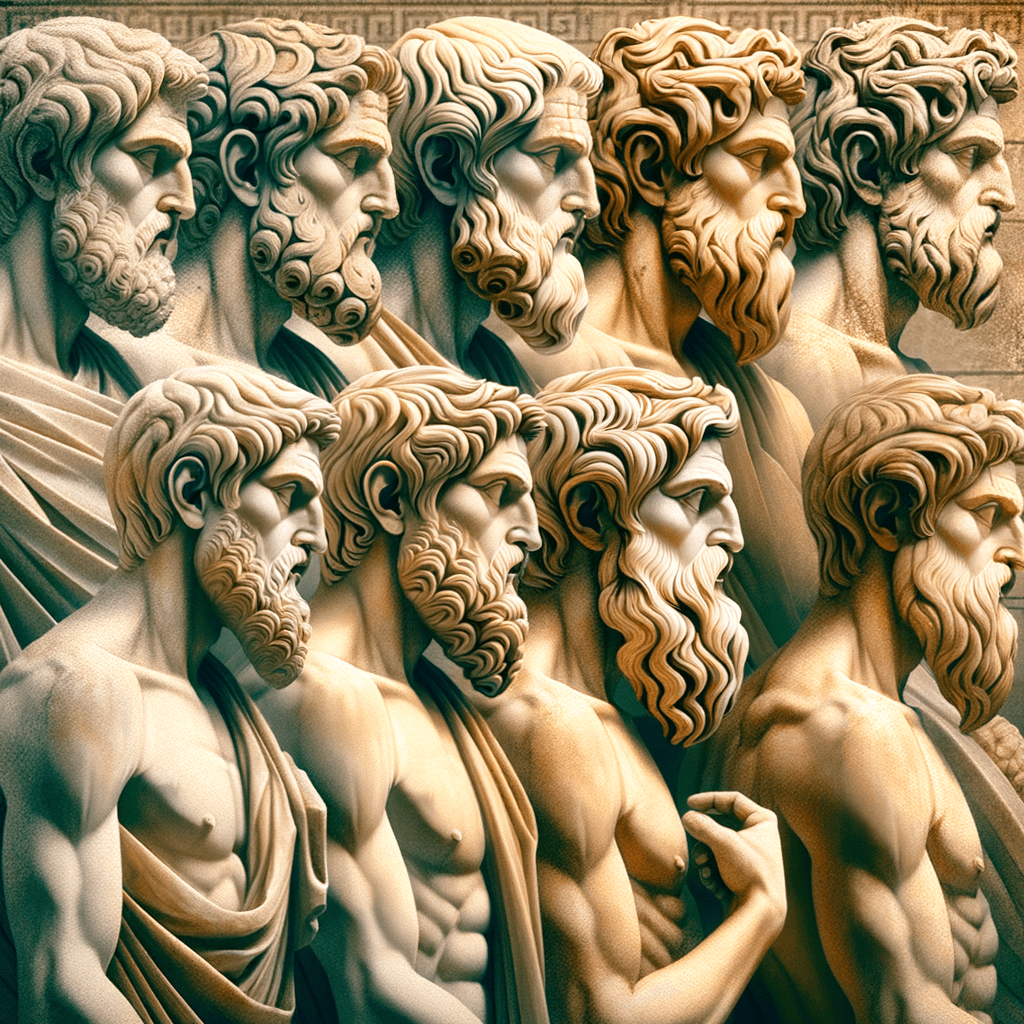Follow the evolution of Greek sculpture through the centuries and discover how the artistic representations of Homeric heroes have transformed over time.
Greek sculpture underwent an extraordinary evolution over the centuries, transitioning from stylized and rigid representations to works of great realism and dynamism. This article will explore how artistic depictions of Homeric heroes transformed over time, reflecting the cultural, social, and technical changes of Greek civilization.
The Origins: The Archaic Period
Greek sculpture has its roots in the Archaic period (circa 800-480 BCE), a time when representations were heavily influenced by Egyptian and Eastern art. Statues from this period, known as kouroi (young men) and korai (young women), were characterized by rigid and frontal poses, with an archaic smile that suggested vitality and serenity.
- Kouroi: These statues depicted young nude men, often athletes or warriors, standing in an upright and symmetrical posture.
- Korai: The female statues were dressed in elaborate garments and displayed greater attention to the details of the fabrics and accessories.
A quintessential example from this period is the Kouros of Anavyssos, a funerary statue that depicts a young man in a rigid pose but with a serene expression.
The Classical Period: The Pursuit of Perfection
The Classical Period (circa 480-323 BC) represents the pinnacle of Greek sculpture, characterized by increasing realism and a greater focus on proportion and movement. Sculptors of this period sought to depict the human ideal, drawing inspiration from principles of harmony and balance.
Among the greatest sculptors of this period are Phidias, Polykleitos, and Myron, whose works have profoundly influenced Western art.
- Phidias: Known for his monumental statues, such as the statue of Zeus at Olympia and the statue of Athena Parthenos in the Parthenon.
- Polykleitos: Renowned for his “Canon,” a treatise on the ideal proportions of the human body, and for the statue of Doryphoros (Spear-Bearer).
- Myron: Renowned for the Discobolus, a dynamic representation of an athlete in motion.
- Classical sculpture introduced the concept of contrapposto, a technique that allows for the representation of the human body in a more natural and dynamic pose, with the weight distributed on one leg and the other slightly bent.
Hellenism: The Expression of Drama and Emotion
The Hellenistic period (circa 323-31 BCE) saw a further development of Greek sculpture, with an increasing emphasis on the expression of drama and emotion. The works of this period are characterized by heightened realism and greater compositional complexity.
Hellenistic sculptors no longer limited themselves to representing the ideal human form but instead explored a wide range of subjects, including children, the elderly, and mythological figures in situations of great pathos.
- Laocoön and His Sons: A sculptural group depicting the Trojan priest Laocoön and his sons as they are attacked by sea serpents, an artwork that intensely expresses pain and struggle.
- Venus de Milo: One of the most famous statues of antiquity, representing the goddess Aphrodite in an elegant and sensual pose.
- Dying Gaul: A sculpture depicting a Gallic warrior mortally wounded, expressing the courage and suffering of the defeated enemy.
- Hellenistic art elevated Greek sculpture to new levels of expressiveness and complexity, profoundly influencing Roman and later art.
The Transformation of Homeric Heroes
The representations of Homeric heroes, such as Achilles, Odysseus, and Hector, have undergone significant transformations over the centuries. In the Archaic period, these heroes were often depicted in stiff and stylized poses, with few individual details.
With the advent of the classical period, Homeric heroes began to be depicted with greater realism and dynamism. The statues from this period show heroes in natural poses, with well-defined muscles and facial expressions that reflect their character and emotions.
During the Hellenistic period, representations of Homeric heroes became even more dramatic and expressive. Sculptors aimed to capture not only the physical beauty of the heroes but also their inner strength and emotional struggles.
- Achilles: Often depicted as a young warrior, strong and handsome, with a determined expression and an athletic body.
- Odysseus: Represented as a wise and cunning man, with a face marked by experiences and adventures.
- Hector: Depicted as a valiant defender of Troy, with an expression of courage and nobility.
The transformations in the representations of Homeric heroes reflect the changes in Greek society and its view of heroism and virtue.
Conclusion
Greek sculpture underwent an extraordinary evolution, moving from stylized and rigid representations to works of great realism and dynamism. The depictions of Homeric heroes are an emblematic example of this transformation, reflecting the cultural, social, and technical changes of Greek civilization.
From the Archaic Period to Hellenism, Greek sculpture continued to evolve, profoundly influencing Western art and leaving a lasting legacy that continues to inspire artists and scholars around the world.
For further insights into Greek sculpture, it is recommended to visit the Encyclopaedia Britannica website.




